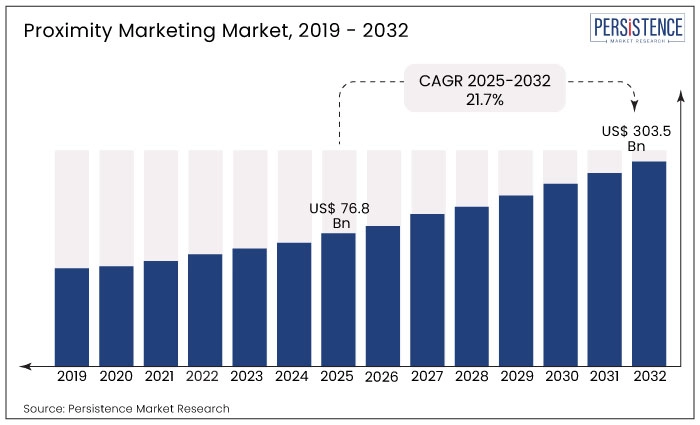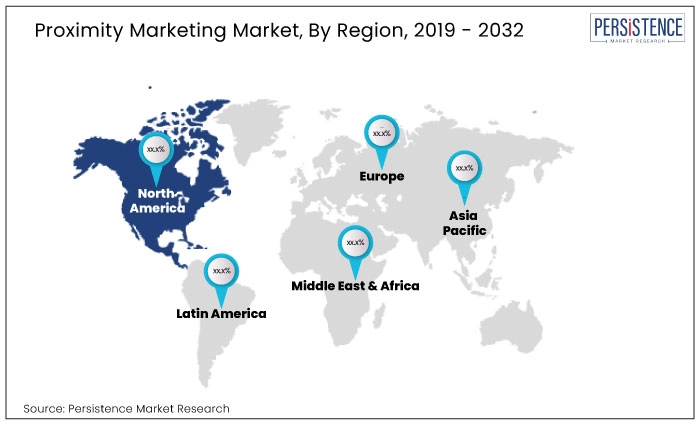ID: PMRREP33468| 309 Pages | 22 Jul 2025 | Format: PDF, Excel, PPT* | IT and Telecommunication

The global proximity marketing industry is projected to reach US$76.8 billion by 2025, growing at a CAGR of 21.7%. According to Persistence Market Research, the industry is projected to reach US$303.5 billion by 2032.
Proximity-based marketing is also called hyperlocal marketing. Due to its narrow focus, it allows businesses to show advertising to consumers in a limited, local area. Advertising and marketing campaigns can be tailored and tracked in detail to make them more effective with proximity marketing devices.
The use of mobile proximity marketing in fast-food outlets and restaurants is a way to show passers-by promotions and attract their attention. Restaurant owners can engage their customers in fun activities and games while waiting for food using the technology and applications available online. Furthermore, they can offer coupons and advertisements to existing clients to entice them back.
With the advent of wireless technology, mobile devices have become more engaging, and the need for personalization has increased. By setting up a digital marketing campaign, proximity marketing gives an impression of personalization. Compared to other advertising campaigns and promotion systems, proximity marketing offers significantly increased results.

| Report Attributes | Details |
|---|---|
|
Market Size (2025) |
US$76.8 billion |
|
Projected Market Value (2032) |
US$303.5 billion |
|
Market CAGR (2025 to 2032) |
21.7% |
|
United States Market Size (2032) |
US$ 111.6 billion |
|
China Market Size (2032) |
US$ 31.2 million |
Persistence Market Research establishes that the global proximity marketing industry expanded at a CAGR of 19.3% between 2019 and 2024. The global market is further anticipated to grow at a 21.7% CAGR between 2025 and 2032.
By leveraging micro-location and proximity marketing, retailers are able to tailor messages to consumers with messages tailored to their unique needs. Several studies have indicated that customer loyalty programs, the integration of local proximity marketing, and geo-loyalty are the key components to retail destinations in the near future since these are effective at engaging consumers in-store and online.
With the popularity of smartphones market steadily rising, proximity marketing is the most effective and compelling method for reaching digitally targeted customers. A growing number of marketing channels are being integrated with proximity marketing, such as mobile apps, social media, and email marketing. Through this integration, users will experience a consistent and engaging user experience across multiple channels, allowing seamless and coordinated marketing campaigns.
Business owners can deliver targeted messages to consumers in real-time based on proximity to specific locations or objects with the help of technologies such as Bluetooth, Wi-Fi, NFC (Near Field Communication), and GPS. These factors are expected to grow demand for proximity marketing in the coming years.
Businesses can deliver contextually relevant and personalized experiences to consumers through proximity marketing market. Businesses can tailor messages and offers according to the interests, behaviors, and surroundings of an individual by leveraging location data and user preferences. By personalizing campaigns, customers are more likely to engage with them and marketing campaigns are more effective.
As location-based technologies have advanced, proximity marketing has become easier. For instance, beacons are small wired devices that transmit signals to nearby smartphones using Bluetooth Low Energy (BLE), which enables businesses to engage with customers when they are close to them. All types of businesses can now take advantage of proximity marketing because the technologies have become more affordable and easier to implement.
With proximity marketing, businesses have access to granular consumer data that allows them to target and segment their campaigns. Data about foot traffic, customer preferences, and purchase behavior can help businesses understand their customers better. By using this data, companies can refine their marketing strategies, improve their campaigns, and target the right audiences.
The expectation of consumers has changed over time and expect brands to provide them with personalized and immersive experiences. Business owners can deliver location-specific offers, content, and recommendations to consumers via market, providing them with a more interactive and engaging experience. Personalized customer experiences are driving proximity marketing growth as businesses strive to meet and exceed customer expectations.
Innovation in Smartphone Technologies and the Penetration of Retail Outlets are Growing Demand
The market is expected to be dominated by North America. By 2032, the North American market is expected to reach US$ 143.08 billion. The United States and Canada are experiencing an increase in smartphone usage, the development of location-based technologies, and the demand for personalized marketing experiences.
During the past few years, proximity marketing in North America has experienced significant growth, allowing advertisers to target advertising or promotional messages based on an individual's location.
During COVID-19, e-commerce and contactless shopping were increasingly popular in this area. Businesses have been exploring new ways of engaging with customers due to contactless interactions and social distancing measures. As a result of proximity marketing, shoppers are able to interact with products online, make contactless payments, and pick up their items curbside.
The United States accounts for 78% of the market share during the forecast period. In 2032, the market is expected to reach US$ 111.6 billion, growing at a CAGR of 20.1%.
The trend of proximity marketing is expected to continue its upward trajectory as more companies recognize the value of targeted and contextually relevant marketing. According to data collected by the United States Bureau of Economic Analysis and the United States Census Bureau, it was reported that the goods and services deficit widened by $1.9 billion in February 2025. In January 2025, the goods and services deficit was $68.7 billion.
Growth of Small Scale Industries is Likely to Increase Demand for Proximity Marketing
The proximity marketing landscape in Asia is expected to lead the way to a large extent. By 2032, the market is expected to be worth US$ 89.79 billion. As a result of PMR's projections, China's market will capture approximately 35% of the total market share by 2032.
According to the projections, China will generate US$ 31.2 billion by 2032. From 2025 to 2032, China's market is forecast to grow at a 22.5% CAGR. A growing number of organizations in the region are choosing proximity marketing as a means of reaching the highest number of customers over the next few years because of the increasing use of smartphones and mobile internet.
Small-scale and large-scale industries are experiencing a growth in demand for proximity marketing, which is increasing each and every day. Growing populations in developing regions and rising disposable incomes will increase demand for proximity marketing. The awareness of online marketing and other business strategies to gain consumers' businesses is growing in the coming years.

Indoor Location is likely to open opportunities for Proximity Marketing
Based on location, the market is segmented into indoor and outdoor proximity marketing markets. According to forecasts, indoor locations will dominate the market over the next few years. Indoor locations are expected to grow at a CAGR of 21.3% between 2025 and 2032.
Business development relies heavily on indoor positioning systems. Using geolocation-based platforms, brands can boost customer loyalty to your brand and lead more effective marketing campaigns. Positioning indoors is gaining popularity every year and is contributing to the performance of companies.
Integrated approaches and advanced technology were utilized to produce reliable results. The advanced devices and solutions also improve connectivity. Location-specific information is gained quickly and effectively, providing proximity marketing services indoors, enhancing navigation and routing within the building, and optimizing workflows through asset and personnel tracking.
Using sensory devices and tracking technologies, indoor navigation systems provide positioning, destination management, and asset-tracking solutions to a broad range of industries, including manufacturing, healthcare, hospitality, and retail. Using a network of wireless devices inside a building, it can be used by employees to locate objects and people within that building. In the last few years, this technology has become ubiquitous within large office buildings, railroad stations, malls and supermarkets, museums, universities, airports, stadiums, and warehouses.
E-commerce and Retail Segment is Expected to Lead the Market during the Forecast Period
The retail & e-commerce segments will drive proximity marketing demand. The market in retail & e-commerce is projected to grow at a CAGR of 21.2% by 2032.
Retailers are becoming increasingly popular with proximity marketing as a way to send special offers and promotions to customers who arrive within a specific proximity to a retail establishment. Using attractive discounts and sales offers at the right time, retailers use the technique of prompting customers.
Proximity marketing has been proven to be effective for years. A practice that is particularly prevalent in the retail sector is geotargeting. For instance, In 2014, Dunkin Donuts began delivering discount coupons to Starbucks customers close to its stores. As a result, they were able to redeem coupons at a much higher rate.
Programmatic targeting is becoming increasingly popular among big brands and small retailers. By offering customers something relevant and timely, Burger King has demonstrated the power of relevance and immediacy. In addition to promoting a new feature within their app, proximity promotions were designed to keep customers from switching to a competitor.
The proximity marketing industry is booming with a number of companies developing apps for the purpose. Gaining a significant share of the market requires an array of products, excellent marketing strategies, and an in-depth understanding of the technical aspects. Different companies can combine their strengths to develop innovative products.
Research and development are often used to develop new products and technologies. Gaining a competitive advantage can be achieved by improving existing products or developing new ones.
Globally, the proximity marketing market was worth US$64.3 billion by 2024.
proximity marketing are expected to generate US$ 76.8 billion in revenue in 2025.
Globally, the proximity marketing market is expected to reach US$ 303.5 billion by 2032.
The proximity marketing market is expected to grow at a CAGR of 21.7% during the forecast period.
Proximity marketing revenue increased by 19.3% between 2019 and 2024.
Retail & E-commerce application are expected to increase by 21.2% by 2032.
Japan's proximity marketing market is expected to grow by 20.8% CAGR.
| Attribute | Details |
|---|---|
|
Forecast Period |
2025 to 2032 |
|
Historical Data Available for |
2019 to 2024 |
| Market Analysis Units | Value: US$ Bn/Mn, Volume: As applicable |
|
Key Countries Covered |
|
|
Key Market Segments Covered |
|
|
Key Companies Profiled |
|
|
Customization & Pricing |
Available upon Request |
By Location:
By Technology:
By Hardware:
By Software:
By Service:
By Application:
By Region:
Delivery Timelines
For more information on this report and its delivery timelines please get in touch with our sales team.
About Author